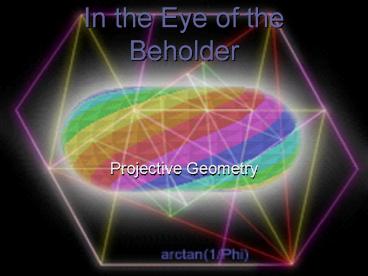In the Eye of the Beholder
Title:
In the Eye of the Beholder
Description:
This inspired artists to try to create what the eye sees on canvas ... Famous Artists. Piero della Francesca (1410-1492) Leonardo da Vinci (1452-1519) Albrecht Durer ... –
Number of Views:213
Avg rating:3.0/5.0
Title: In the Eye of the Beholder
1
In the Eye of the Beholder
- Projective Geometry
2
How it All Started
- During the time of the Renaissance, scientists
and philosophers started studying the world
around them. - This inspired artists to try to create what the
eye sees on canvas - They ran into a problem how to portray depth on
a flat surface - Artists came to the realization that their
problem was geometric and started researching
mathematical solutions - This is what led into what we know today as
projective geometry
3
What is Projective Geometry?
- Originated from the principles of perspective art
- Central principle two parallel lines meet at
infinity - A branch of geometry dealing with properties and
invariants of geometric figures under projection. - Higher geometry
- Geometry of position
- Descriptive geometry
- Projective Geometry is non-Euclidean, however it
can be thought of as an extension of Euclidean
geometryand this is why
4
The Extension
- The direction of each line is included in the
line itself as an extra point - A horizon of directions corresponding to coplanar
lines is thought of as a line - Because of this, two parallel lines will meet on
a horizon as long as the possess the same
direction - In essence directionspoints at infinity and
horizonslines at infinity - All points and lines are treated equally
5
The Axioms of Projective Geometry
- With the extension now the axioms become easier
to understand - Every line contains at least 3 points
- Every two points, A and B, lie on a unique line,
AB - If lines AB and CD intersect, then so do lines AC
and BD, assuming that A and D are distinct from B
and C
6
Euclidean or non-Euclidean?
- The reason that a line contains at least three
points is easy to see when thinking of Euclidean
space and then adding to that points and lines at
infinity. The third point is considered the
direction of the line - The second axiom has a similar form of Euclids
fifth postulate - There are numerous other examples of how closely
related projective and Euclidean geometry are - It seems ironic then, that Projective geometry is
considered non-Euclidean
7
Influential People
- Filippo Brunelleschi (1377-1446)
- first person to study intensively
- Leone Battista Alberti (1404-1472)
- screen images are called projections
- How are the images related?
- painting a picture as the canvas was a window or
screen - if an object is viewed from different locations,
the screen images or projections are
different - Study of projections termed projective geometry
8
Famous Artists
Piero della Francesca (1410-1492)
Albrecht Durer (1471-1528)
9
Activity 1
- Another way of thinking about this involves using
a light source instead of your eyes - Things that change
- Distance
- Angle measure
- Curvature
- Things that dont change
- Straight lines
10
German and French Followers
- Gerard Desargues (1593-1662)
- projected conic sections and circles are always
conic section - Jean Victor Poncelet (1788-1867)
- influential book on projective geometry in a very
unlikely place
11
Activity 2
- Railroads are a classic way of demonstrating
perspective. Lets construct a set of receding
railroad tracks!
12
Principle of Duality
- Principles in projective geometry occur in dual
pairs by interchanging line and point where
appropriate. - Two points determine exactly one line.
- Duality interchanges line and point.
- Two lines determine exactly one point. These
statements are duals of each other.
13
Mystic Hexagram
- Blaise Pascal (1623-1662)
- Hexagram inscribed in a conic section
- Hexagram circumscribed about a conic section
- Duality proves this automatically!
14
A hexagram can be inscribed in a conic section if
and only if the points (of intersection)
determined by its three pairs of opposite sides
lie on the same (straight) line.
15
Applying Projective Geometry
- Used to describe natural phenomena such as
- tension between central forces and peripheral
influences - organic developments
- The forms of buds of leaves and flowers, pine
cones, eggs, and the human heart can all be
described as path curves. When a single
parameter interacts with these path curves,
growth measures are formed, which are
representations of organic forms. Without
projective geometry, there would be no other way
to mathematically describe these forms. If
negative values were used for the parameter, the
inversions then represent vortexes of water and
air.
16
Timeline
- 1377-1446 Brunelleschis first study of
projective geometry - 1404-1472 Albertis projection studies
- 1593-1662 Desargues discovery of projected
conic sections and circles always being conic - 1788-1867 Poncelets influential book
- 1623-1662 Pascals Mystic Hexagram
17
References
- Weisstein, Eric W. Projective Geometry. From
Math World-A Wolfram Web Resource.
http//mathworld.wolfram.com/ProjectiveGeometry.ht
ml - Projective Geometry. Wikipedia. November 25,
2006. http//en.wikipedia.org/wiki/Projective
_geometry - Berlinghoff, William P. and Gouvea Fernando Q.,
Math Through the Ages. Oxton House Publishers,
2002.
18
Thank You!
- Lisa Carey and Sara Smith















![10 Eye-Catching Pics Caught By The Best ‘Shutterbugs’ [In Pics]](https://s3.amazonaws.com/images.powershow.com/8593660.th0.jpg?_=20160820068)















